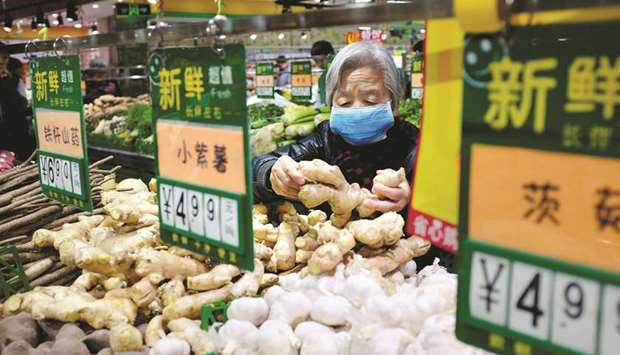China’s producer prices in December rose at their slowest pace in more than two years, a worrying sign of deflationary risks that could see Beijing roll out more policy support to help stabilise the economy.
Consumer inflation for the month also eased from a year earlier due to lower non-food prices, data from the National Statistics Bureau (NBS) showed yesterday, short of market forecasts and well below Beijing’s target.
Analysts say the sharper-than-expected pullback in prices raises the possibility of more stimulus measures even though China’s central bank just reduced the ratio of cash that banks must hold as reserves in January, the fifth cut in a year.
The slowdown in domestic demand has added to the list of economic worries for China, which is mired in a trade war with the United States, its biggest trading partner.
“Slumping PPI inflation suggests corporate earnings will almost surely continue to fall in coming months,” analysts at Nomura said in a note. “We expect PPI inflation to soon return to negative territory, reducing inventory stocks and exerting further downward pressure on China’s growth.”
The producer price index (PPI), a measure of the prices businesses receive for their goods and services, rose 0.9% in December from a year earlier – below the lowest forecast in a Reuters poll of 35 economists who had a median estimate of 1.6%.
The index rose 2.7% in November.
The PPI fell a steeper 1% from November, its biggest fall since January 2015. November’s index weakened 0.2% from the previous month.
Slowing inflation leaves policymakers with plenty of room to loosen policy, Capital Economics said in a note.
The consumer price index (CPI) rose 1.9% in December from a year earlier, down from 2.2% in November and below expectations of a 2.1% gain.
The government’s full-year target for consumer price inflation is around 3%.
On a month-on-month basis, the CPI was unchanged.
Xu Hongcai, deputy chief economist at China Centre for International Economic Exchanges, a Beijing-based think tank, said he expects the central bank to cut reserve requirement ratio (RRR) for banks by another 2 percentage points this year.
While the chances of cutting benchmark interest rates remain low, Betty Wang, senior China economist at ANZ Research, said such radical stimulus measures may even become possible if the weak price trend persists.
“The weakness is a signal worthy of vigilance,” she said.
China stocks recouped losses to edge higher as softer inflation readings raised prospects for further stimulus. China’s factory activity contracted for the first time in more than two years in December, highlighting the challenges facing Beijing as it seeks to end a bruising trade war with Washington and reduce the risk of a sharper economic slowdown in 2019.
Domestic demand for industrial goods and services has eased in recent months as the government’s multi-year campaign to curb corporate debt and risky lending practices has crimped capital spending and corporate investment. The uncertainty created by the trade war with the United States is also hanging over China’s economy, even though both sides have agreed to a 90-day time-out.
There are concerns that the tariff war could still escalate once the truce ends, putting more pressure on Chinese authorities to bolster the economy.
Yesterday’s data show factory-gate prices for raw materials rose 0.8% last month from a year earlier, down from a 4.6% rise in November.
Price rises in the production and processing sector slowed in December from the previous month.
Easing PPI inflation was led by oil and natural gas extraction, fuel processing, chemical products manufacturing, non-metallic mineral products manufacturing and ferrous metal processing.
The five industries combined to reduce headline PPI inflation by 1.71 percentage points, according to the NBS.
The slowdown in consumer inflation was mainly due to non-food prices, as transportation and health care prices weakened on lower oil costs and drug pricing reforms.
The food price index in December rose 2.5% from a year earlier, the same as in November, while non-food inflation moderated to 1.7% from 2.1%.
The core consumer price index, which strips out volatile food and energy prices, rose 1.8% in December, in line with the level seen in November.

A resident selects ginger at a supermarket in Beijing. China’s consumer inflation for December eased from a year earlier due to lower non-food prices, data from the National Statistics Bureau showed yesterday.


